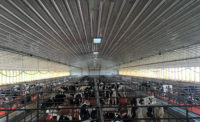Back On Track With Japan
Deborah Silver
editor, ProvisionerOnline
editor, ProvisionerOnline
Although agricultural talks between Japan and the United States ended Friday, May 19, without a definite timeline for reopening the once-lucrative Japanese market to American beef, all signs point toward a positive resolution — and soon.
Indeed, the meetings, which ran for 2 1/2 days, appeared to proceed without a hitch. Japan gave its approval to a U.S. safety report on 35 U.S. meat-packing facilities certified to export beef to Japan. Chuck Lambert, the U.S. Department of Agriculture’s undersecretary for marketing and regulatory programs and head of the U.S. delegation, confirmed that, indeed, all eligible U.S. plants complied with Japanese import rules. And at the close of the talks, Lambert voiced optimism that the U.S. beef industry likely could expect an early-summer lifting of the import ban.
The Japanese media proved even more enthusiastic. “Beef ban dropped to avoid political stew,” the headline of one Japanese newspaper declared prematurely. “U.S. beef imports to resume,” announced another. Although U.S. media outlets took more of a glass-half-full approach — “Talks end without schedule to resume beef exports to Japan,” headlined an Associated Press story — even the most cautious of them concluded that the Japanese border most likely will open to U.S. beef around July.
Of course, we’ve been here before — or at least close to here. After Japan eased its initial ban of U.S. beef in December 2005, allowing the import of meat from 20-month-old cows, it quickly slammed the door shut the following month when spinal bones were found in a shipment of American veal.
A sudden and dramatic reaction, yes, but not unexpected. It’s only natural that Japanese officials would react so strongly to any incident of bovine spongiform encephalopathy (BSE). After all, Japan itself has a well-documented BSE problem. Out of 5 million animals in Japan, the country has reported 23 BSE cases. In comparison, only four to seven of the 42 million adult animals in the United States are estimated to have BSE.
The U.S. beef industry has certainly done its due diligence to ensure Japan that the BSE situation is under control in this country, with an extensive system in place that includes comprehensive testing, extensive monitoring and thorough reporting. For those Japanese officials interested in a closer look, there’s an open-door plant policy at export-eligible U.S. plants
Now, some six months after Japan’s last beef import lockdown, it’s clear that Japan is ready to do business. And not just because the BSE-risk factor from U.S. beef is so small. Some believe that the impending agreement is a way for Japan to show consideration to President Bush, who is facing slumping approval ratings ahead of mid-term elections. A political gift, of sorts. And the upcoming June summit in Washington, D.C., between Prime Minister Junichiro Koizumi of Japan and President Bush likely has something to do with the agreement’s forward momentum. Neither Washington nor Japan wants the two leaders at odds on this issue during Koizumi’s visit. Plus, dissatisfaction over the prolonged Japanese ban on U.S. beef is mounting in the U.S. meat industry, and both the current administration and Congress are feeling the industry’s pressure. After all, Japan was once the most profitable overseas market for U.S. beef, with about $1.5 billion in sales annually. It’s safe to say that Japan is also feeling the heat.
That said, it’s safe to say that it’s time to lift the ban. Let’s just make sure that the U.S. beef industry is at the top of its game this time.



Report Abusive Comment